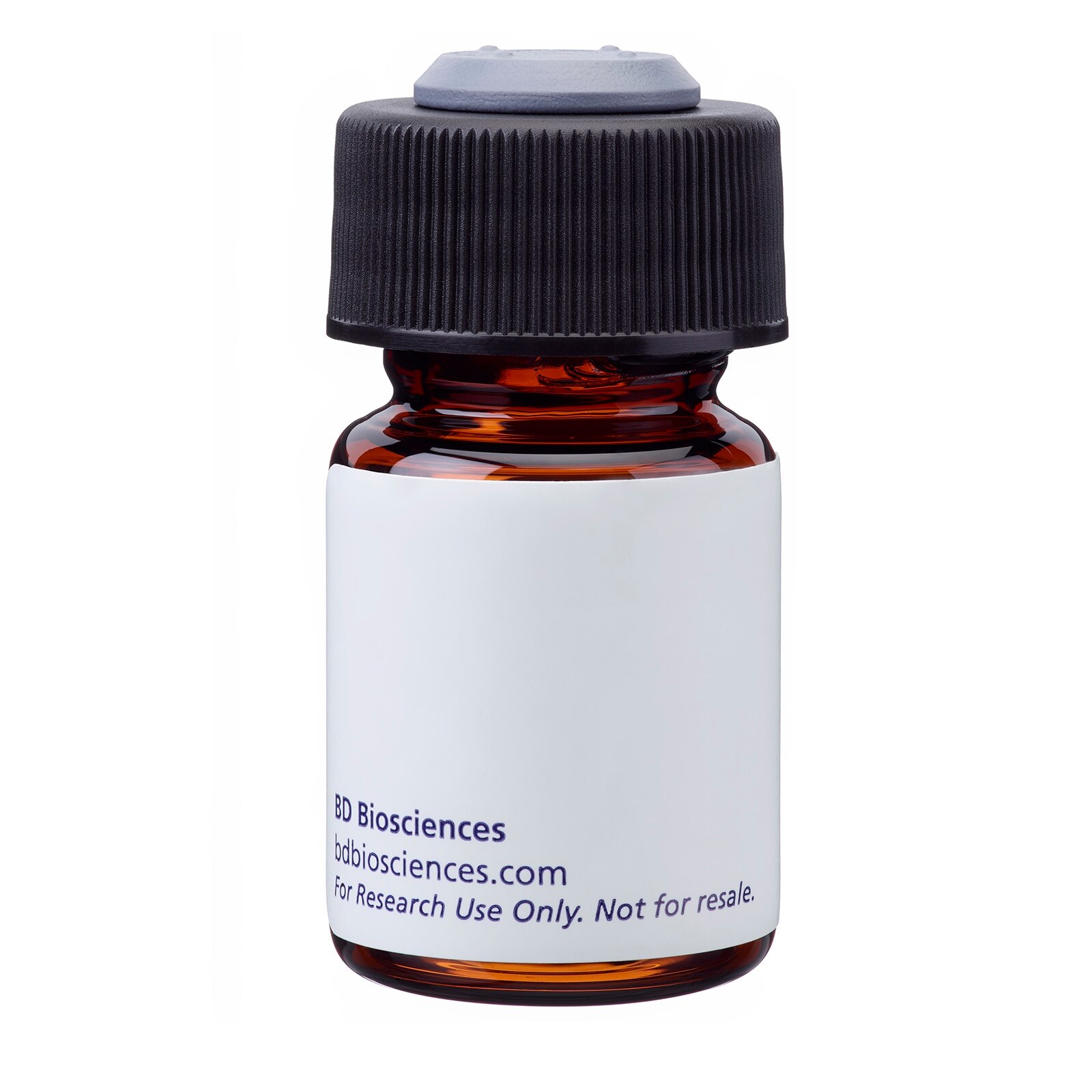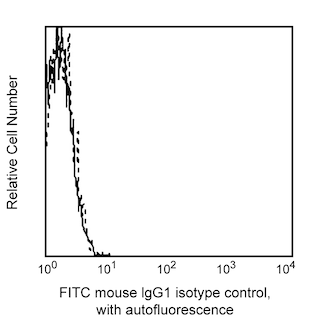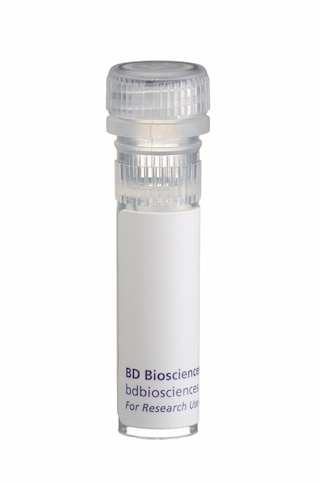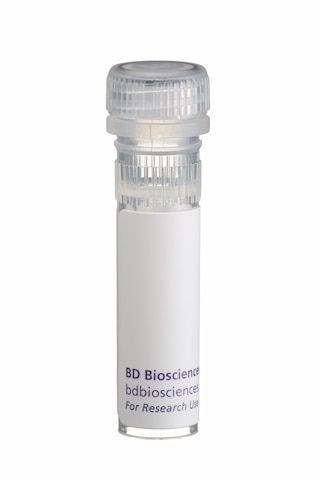-
Your selected country is
Middle East / Africa
- Change country/language
Old Browser
This page has been recently translated and is available in French now.
Looks like you're visiting us from {countryName}.
Would you like to stay on the current country site or be switched to your country?




Flow cytometric analysis of CD83 expression on cultured human dendritic cells. Human peripheral blood monocytes were treated with 20 ng/ml of Recombinant Human IL-4 (Cat. No. 554605), and 20 ng/ml Recombinant Human GM-CSF (Cat. No. 550068) proteins for 7 days at 37°C. In addition, 20 ng/ml Recombinant Human TNF (Cat. No. 554618) was added for the last two days of culture. The cells were then stained with either FITC Mouse IgG1, κ Isotype Control (Cat. No. 555748; dashed line histogram) or FITC Mouse Anti-Human CD83 antibody (Cat. No. 556910/560929; solid line histogram). The fluorescence histogram showing CD83 expression (or Ig Isotype control staining) was derived from gated events with the forward and side light-scatter characteristics of viable dendritic cells. Flow cytomtery was performed on a BD FACScan™ system.


BD Pharmingen™ FITC Mouse Anti-Human CD83

Regulatory Status Legend
Any use of products other than the permitted use without the express written authorization of Becton, Dickinson and Company is strictly prohibited.
Preparation And Storage
Product Notices
- This reagent has been pre-diluted for use at the recommended Volume per Test. We typically use 1 × 10^6 cells in a 100-µl experimental sample (a test).
- An isotype control should be used at the same concentration as the antibody of interest.
- Caution: Sodium azide yields highly toxic hydrazoic acid under acidic conditions. Dilute azide compounds in running water before discarding to avoid accumulation of potentially explosive deposits in plumbing.
- Source of all serum proteins is from USDA inspected abattoirs located in the United States.
- For fluorochrome spectra and suitable instrument settings, please refer to our Multicolor Flow Cytometry web page at www.bdbiosciences.com/colors.
- Species cross-reactivity detected in product development may not have been confirmed on every format and/or application.
- Please refer to www.bdbiosciences.com/us/s/resources for technical protocols.
Companion Products






The HB15e monoclonal antibody specifically binds to a 45 kDa type 1 transmembrane glycoprotein member of the Ig superfamily. CD83 is composed of a single V-type Ig extracellular domain with a C-terminal cytoplasmic tail. Cell surface CD83 is expressed mainly by follicular dendritic cells, circulating dendritic cells, interdigitating dendritic cells in lymphoid tissues, in vitro-generated dendritic cells and thymic dendritic cells. However, its expression is not restricted to dendritic cells. CD83 is also expressed on some germinal center B cells and some lymphoblastoid cell lines. Although its function is not known, it may play a role in cell-cell interaction during antigen presentation.

Development References (8)
-
Hart DN. Dendritic cells: unique leukocyte populations which control the primary immune response. Blood. 1997; 90(9):3245-3287. (Biology). View Reference
-
Kishimoto T. Tadamitsu Kishimoto .. et al., ed. Leucocyte typing VI : white cell differentiation antigens : proceedings of the sixth international workshop and conference held in Kobe, Japan, 10-14 November 1996. New York: Garland Pub.; 1997.
-
Knapp W. W. Knapp .. et al., ed. Leucocyte typing IV : white cell differentiation antigens. Oxford New York: Oxford University Press; 1989:1-1182.
-
Schlossman SF. Stuart F. Schlossman .. et al., ed. Leucocyte typing V : white cell differentiation antigens : proceedings of the fifth international workshop and conference held in Boston, USA, 3-7 November, 1993. Oxford: Oxford University Press; 1995.
-
Summers KL, Daniel PB, O'Donnell JL, Hart DN. Dendritic cells in synovial fluid of chronic inflammatory arthritis lack CD80 surface expression. Clin Exp Immunol. 1995; 100(1):81-89. (Biology). View Reference
-
Weissman D, Li Y, Ananworanich J, et al. Three populations of cells with dendritic morphology exist in peripheral blood, only one of which is infectable with human immunodeficiency virus type 1. Proc Natl Acad Sci U S A. 1995; 92(3):826-830. (Biology). View Reference
-
Zhou LJ, Schwarting R, Smith HM, Tedder TF. A novel cell-surface molecule expressed by human interdigitating reticulum cells, Langerhans cells, and activated lymphocytes is a new member of the Ig superfamily. J Immunol. 1992; 149(2):735-742. (Biology). View Reference
-
Zhou LJ, Tedder TF. Human blood dendritic cells selectively express CD83, a member of the immunoglobulin superfamily. J Immunol. 1995; 154(8):3821-3835. (Biology). View Reference
Please refer to Support Documents for Quality Certificates
Global - Refer to manufacturer's instructions for use and related User Manuals and Technical data sheets before using this products as described
Comparisons, where applicable, are made against older BD Technology, manual methods or are general performance claims. Comparisons are not made against non-BD technologies, unless otherwise noted.
For Research Use Only. Not for use in diagnostic or therapeutic procedures.
Report a Site Issue
This form is intended to help us improve our website experience. For other support, please visit our Contact Us page.